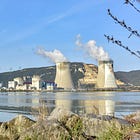Europe's New Industrial Challenge
Europe cannot match China's scale—but it doesn't need to
China builds 232 times more ships than America by tonnage. It produces thirteen times more steel. Every year, it adds more solar capacity than America has ever installed. These numbers represent more than economic statistics—they signal a fundamental shift in global manufacturing power that poses an existential question for Europe: how do you compete when your rival operates at unprecedented scale?
The conventional answer is to match that scale. Build bigger factories, chase lower costs, copy successful models. But for Europe, this path leads nowhere. China’s manufacturing dominance rests on advantages Europe cannot replicate: a unified market of 1.4 billion people, state coordination across vast industrial ecosystems, and production volumes that trigger Wright’s Law across multiple sectors simultaneously.
Yet Europe possesses different strengths. It has skilled workforces, advanced institutions, and the financial sophistication to leverage technology in ways that China’s mass-production model cannot easily match. The question is not whether Europe can outproduce China—it cannot. The question is whether Europe can compete differently, using intelligence and integration to achieve the benefits of scale without requiring mass.
This edition argues that Europe can. But success demands abandoning comfortable assumptions about how manufacturing competition works. It requires focusing on critical technologies, building dense industrial clusters, developing new forms of patient capital, and using artificial intelligence to compress learning curves that traditionally require massive output. Most importantly, it requires connecting Europe’s emerging technology startups with its established manufacturers in ways that create competitive advantage rather than mere efficiency gains.
Each actor in this ecosystem has a role to play. For clarity, I use two terms throughout this essay. “New Industrials” (coined by Gregory Bernstein) are startups embedding advanced technology directly into production and supply chains. “Legacy Industrials” are established manufacturers with scale, infrastructure, and market experience. The argument that follows hinges on how these two groups interact, and how investors act as the bridge between them.
1/ China dominates global manufacturing
It has taken years, and the work of leading analysts and authors, to understand what makes China so dominant in large-scale manufacturing. The secret is not low labour costs—they are no longer particularly low. Instead, China’s advantage comes from rediscovering the old formula for manufacturing supremacy: the Marshallian Trinity. This combines a dense pool of skilled workers who share knowledge, ready access to capital and modern infrastructure, and a network of supportive institutions that coordinate firms, suppliers, and research. Together, these elements form a self-reinforcing ecosystem that drives efficiency, innovation, and scale.
And talk about scale! China controls 32% of global manufacturing while the US produces 15%, a gap projected to widen to 40% versus 11% by 2030. The scale differential spans multiple sectors: China produces 13 times the steel of the US, builds 232 times more ships by tonnage, and manufactures 60% of global electric vehicles. It consumes 30% of the world’s electricity and adds annual solar capacity exceeding total US installations. With 1.6 million engineering graduates each year—compared with America’s lawyer-heavy output—China has systematically built industrial capacity that converts manufacturing dominance into geopolitical leverage.
Adam Tooze argues that China’s unprecedented scale and rapid development represent such a radical departure from all previous human history that conventional social science models, designed for smaller cases, cannot explain it; rather, it constitutes the central dynamic defining modern globalization and development.
When a nation produces at such scale, it benefits immensely from what is known as Wright’s law: costs decline predictably with cumulative production volume. Chinese manufacturers have achieved production scales across multiple sectors that create systematic cost advantages through learning curves, supplier networks, and capital efficiency.
This concentration of industrial power sets the stage for a stark contrast with Europe, where smaller-scale production, dispersed supply chains, and different institutional structures produce very different economic outcomes.
2/ Europe struggles with manufacturing scale
Europe’s manufacturing remains strong yet fragile. German machinery exports reached €66.8 billion in 2023, while northern Italy hosts both luxury goods and a dense network of high-value industrial firms. Nordic countries lead in cleantech niches, and France maintains a nuclear technology presence. Manufacturing makes up about 24% of the EU economy, compared with 11% in the US.
Europe’s share of global manufacturing value added declined from 27% in 2000 to 16% in 2014—and even below that since then. Chinese steel output now exceeds European production sixfold. Where scale determines success, China wins decisively.
Europe excels in markets where scale matters least: bespoke engineering, luxury goods, and specialised machinery. These sectors require intensive customer interaction. A German machine tool manufacturer does not just sell equipment; it provides months of consultation and years of service. Europe’s fragmentation turns this into a complex task, requiring navigation of multiple languages, regulations, and commercial practices. The history of France’s nuclear industry reveals the challenge: domestic standardisation once delivered 58 reactors efficiently, but exports demanded customisation, eroding economies of scale.
The inverse relationship between scale and customisation hits Europe hard. Fragmentation magnifies the effect: each national market demands unique specifications, creating what Seth Godin calls client–customer confusion. European firms rely on a handful of demanding clients rather than broad customer bases like Chinese competitors.
Eurozone structural imbalances worsen the problem. Southern Europe’s unemployment represents idle capacity, while northern wage repression, especially in Germany, prevents natural adjustment. The shared currency burdens both sides: southern industrialists face an overvalued euro, while German workers see suppressed wages despite strong exports.
Finally, large-scale European projects face bureaucratic obstacles similar to the US. Europe has evolved into what Dan Wang, in his recent book Breakneck (now a New York Times best seller) calls a “lawyerly society” rather than an “engineering state” like China. Regulatory processes can take years while Chinese competitors break ground.
All in all, Europe remains strong in specialised niches but struggles in mass markets, held back by fragmentation and institutional limits. In contrast, China’s scale-driven ecosystem exposes the structural gaps that shape global competitiveness.
3/ There’s no easy path to learning from the Chinese
Before considering how Europe should defend and expand its position in global manufacturing, let’s examine the idea of learning from the Chinese through joint ventures. After all, that is exactly what China did decades ago: they absorbed as much as they could from the West, welcoming Western manufacturers at home and forming joint ventures with knowledge-hungry local players.
In a June Bloomberg article, Dan Wang and Ben Reinhardt argued that America could follow the exact same playbook: invite Chinese manufacturers into joint ventures. For the Chinese, it would be an easy proposition—they could deploy their abundant dollar-denominated capital to produce closer to the American consumers they covet, while American manufacturers would gain a chance to learn and catch up. At first glance, it seems like a shortcut to competitiveness and industrial renewal.
I tested the idea with friends and colleagues: should Europe try the same approach, forming joint ventures with Chinese manufacturers? Three major objections emerged.
First, two exporting powers struggle to align. Both Europe and China depend on exports. Any deep partnership such as promoting joint ventures in Europe would force one side to import more, upsetting its economic model—and China’s scale and state capacity would dominate such a relationship. A LinkedIn post I wrote recently highlights this structural tension: Europe cannot simply pivot to China without undermining its own economic base.
Second, joint ventures succeed mostly in developing economies—less so in developed ones like Europe. They rely on a mindset willing to experiment, absorb knowledge, and scale fast. China from the 1990s onward exemplified this: disciplined learning, combined with long-term innovation and massive buildout, created a strong feedback loop toward manufacturing excellence. Europe lacks that mindset today. Its institutions, regulations, and high costs make learning from a foreign partner slower, more complex, and riskier. Attempting a joint-venture approach now risks what we might call structured dependency: gaining access to Chinese know-how without developing independent capabilities.
Third, cultural and operational gaps are real. Anecdotes abound of Chinese firms buying European companies, mismanaging local workforces, and moving operations back to China. Even without geopolitical tension, aligning across such differences is difficult.
Europe can still learn from China, but trying to replicate their approach of inviting Chinese partners risks dependency rather than independence. The safer path lies in selective technology partnerships, knowledge exchanges, and domestic capacity-building. Europe needs to strengthen its own processes, workforce, and institutions rather than bet the whole house on a joint-venture shortcut.
This is not a rejection of cooperation, but a note of caution: learning from China may require adaptation rather than straightforward imitation. Europe would do well to consider the potential pitfalls of handing over the keys to the Chinese through joint ventures as it explores ways to strengthen its own industrial base.
One way to do this is by mastering what writer Noah Smith and entrepreneur Sam D’Amico call the “Electric Tech Stack”—the set of core technologies that underpins modern manufacturing and strategic industries. By investing across batteries, motors, power electronics, and semiconductors, Europe can build an industrial base informed by China’s example while remaining independent.






